
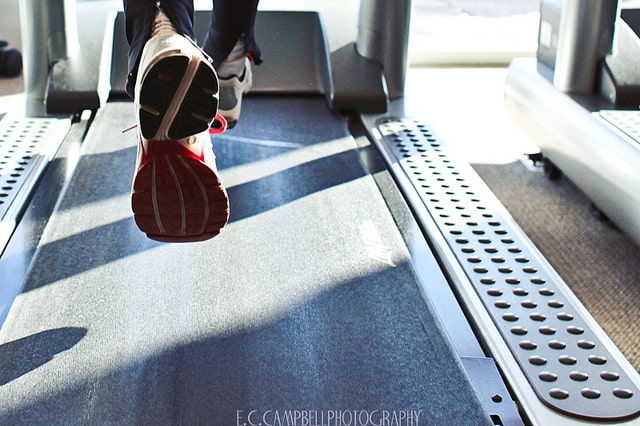
High intensity circuits, high intensity interval training (HIT) and fasted cardio are all popular calorie burning methods.
But which strategy is best for you?
HIIT
If you look at any fitness intensity chart from the 80’s and 90’s, you’ll see a zone referred to as the fat loss zone, which corresponds to roughly 60% of your max heart rate. Trainees were encouraged to workout in this zone because it was thought that fat would be primarily burned for fuel and therefore, reduce overall bodyfat. Then in the 2000s, along came HIIT and EPOC (excess post-exercise oxygen consumption). HIIT involves alternating bouts of high- and low-intensity exercise, designed to increase the total amount of high-intensity work performed during one training session (Schoenfeld & Dawes, 2009) and EPOC refers to the calorie expenditure required for recovery, post workout. A HIIT protocol performed with cardiovascular exercise can include hard sprints followed by easy jogging while a HIIT protocol using weights can include sets of a barbell complex performed with short rest periods between sets.
Research has shown that fat-burning zone-type cardio pales in comparison to HIIT when it comes to maximizing fat loss, as total caloric expenditure and fat breakdown are greater in an HIIT protocol (Schoenfeld & Dawes, 2009). Because of the high-intensity of HIIT, your homeostasis is taken further from its equilibrium compared to a similar session at a lower intensity. Therefore, in addition to burning more calories during the training session, your body will continue to expend calories post-workout (via the EPOC phenomenon) until your body reaches homeostatic equilibrium. This is commonly referred to as a metabolic disturbance; hence, HIIT also being referred to as metabolic disturbance training.
Fasted Cardio
Fasted cardio involves performing cardiovascular exercise, at a high- or low-intensity, on an empty stomach. The theory and belief behind this method of training is that the body will utilize fat as the main energy source, instead of carbohydrates, therefore resulting in greater fat loss (Schoenfeld, 2011).
According to Brad Schoenfeld, MS, CSCS (New York), a lecturer in exercise science and author of the Max Muscle Plan, this form of training “confers any fat loss benefits over and above non-fasted cardio” and that science does not support its efficacy (Schoenfeld, 2011). Tony Gentilcore, CSCS (Hudson, MA), strength coach and co-founder of Cressey Performance, says the “substrate you’re burning doesn’t really matter during [the actual training session.]”
If you have more fuel in your system, you should be able to train at a higher intensity and hypothetically burn more total calories overall, states Gentilcore. Eating a pre-workout meal is actually associated with a greater number of expended calories both during and after the workout and therefore enhances fat loss, compared to working out in a fasted state (Schoenfeld, 2011). There are several factors that influence fat mobilization and usage from subcutaneous adipose tissue says Schoenfeld. “It is shortsighted to look solely at how much fat is burned during an exercise session,” he states as “the human body is very dynamic and continually adjusts its use of fat for fuel.” Schoenfeld (2011) adds, “if you burn more carbohydrates during a workout, you inevitably burn more fat in the post-exercise period and vice versa.” Therefore, training fasted or fed does not directly influence your ability to burn fat for fuel.
According to Schoenfeld, the “bottom line is that in trained individuals, there does not seem to be any advantage to fasted cardio from a fat loss standpoint.” In addition, training with depleted glycogen levels (carbohydrate stores) has been shown in the research to increase protein breakdown, a process with detrimental effects for trainees concerned with building muscle and strength (Schoenfeld, 2011).
Fat Loss Folly: More Is Not Better
Gentilcore cautions trainees from taking their conditioning too far because “there comes a rate of diminishing returns [when thinking] more is better.” Protein synthesis and muscle building may be sacrificed if too much HIIT and cardiovascular exercise is added to a training program, says Gentilcore. Schoenfeld agrees stating that combining high training volumes with high intensity workouts of both weightlifting-type and aerobic-type exercise can result in overtraining and “impair protein accretion as well as [have] negative effects systemically on the body, that impairs results.” Stop worrying about burning fat on an hour-to-hour basis and instead consider it over the course of several days to see how it impacts your body composition (Hansen et al., 2005).
Putting it Into Action
Adding muscle to your frame takes a dedicated bodybuilding program complimented with a healthy nutritional plan with a slight calorie surplus. Depending on this surplus, additional calories may be stored as fat, taking away from the appearance of shredded striated muscles. When adding fat loss workouts to your program, focus on these tips:
If your goal is purely hypertrophy, focus on your bodybuilding program and add in low-intensity cardio as a separate training session if you think it’s necessary. Depending on your recovery ability, you can add 2-4 low-intensity aerobic sessions per week. An example session may involve an incline treadmill walk for 30-60-minutes as 60-65% of your max heart rate. Going for a walk around your neighborhood is also a great alternative. This form of training will not take too much out of you, unlike HIIT; therefore, saving energy for your muscle building workouts.
If your goal is purely fat loss, incorporate these training sessions in the fed-state:
2-3 sessions/week of HIIT with weights (e.g. barbell complexes, resistance training circuits, sled pushes, kettlebell swings, etc.)
1-2 sessions/week of HIIT performing sprints (e.g. hill, track, spin bike, etc.)
1-2 sessions/week of low-intensity cardio
Just as with the hypertrophy protocol, pay attention to your body and recovery ability before adding more training sessions to your program.
References
Hansen, K., Shriver, T., & Schoenfeld, D. (2005). The effects of exercise on the storage and oxidation of dietary fat. Sports Med, 35, 363-373.
Schoenfeld, B. (2011). Does cardio after an overnight fast maximize fat loss? J of Strength and Cond, 33(1), 23-25.
Schoenfeld, B., & Dawes, J. (2009). High intensity interval training: Applications for general fitness training. J of Strength and Cond, 31(6), 44-46.
This article first appeared on MuscleMag.com
photo credit: eccampbell via photopin cc
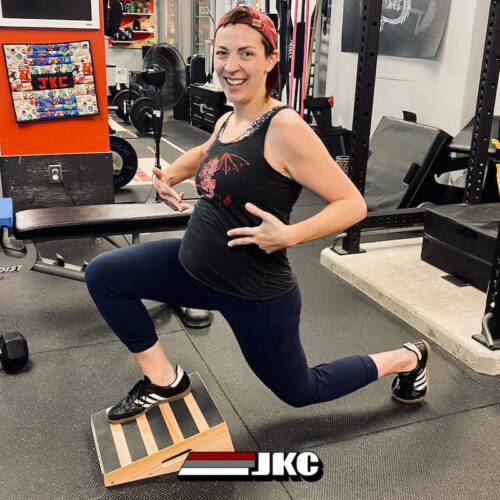
I started training at JKC in 2016 because I’ve always had upper back issues that became aggravated through work. I sought out other training and physio, but experienced little to no results. A client of mine happened to be coming to JKC for a similar issue and highly recommended it. I have had great success and haven’t looked back! I always feel like I’m getting programs tailored to my needs and I’m never bored. I’m 30 weeks pregnant now with my second child and have been able to workout through both pregnancies here at JKC. Even on my least mobile days, I felt safe to workout because my programs were specifically modified for my needs.
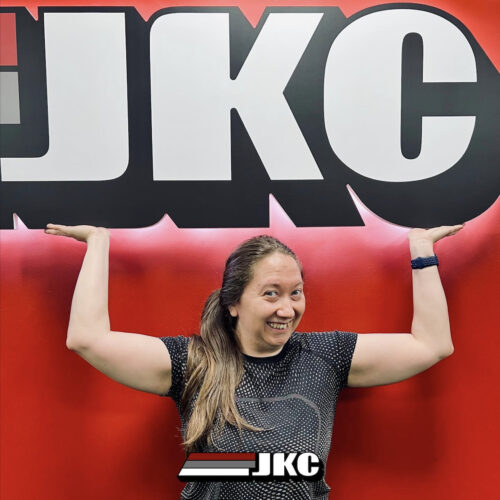
I originally joined JKC because I was anxious about passing out and embarrassing myself since I hadn’t weight trained in a while and I’d hoped to find somewhere sympathetic. My husband @terry_hussey had been training at JKC and his success there made me miss the achievement you feel from a good workout. I went to meet Jon and immediately knew it was going to be a safe space for me. I was never judged for the fears I had and where I was starting from. Jon and Thomas made sure to check on me often, and found a way to challenge me but make me feel secure at the same time, and Terry and I were able to book sessions together, so working out became a shared win for us!
JKC is different from other gyms because of the personal growth you have outside JKC (the sessions inside JKC creates a great positive feedback loop!). You gain self confidence, learn how to show up for yourself, meet a community of newfound friends, and get the support of your trainers who are behind you 100%. I’ve left a scattered workout so proud of myself I’ve honestly shed a tear in the car on the drive home. JKC is the mental health relief valve I need to stay positive, and keep my anxiety and health related fears at bay.
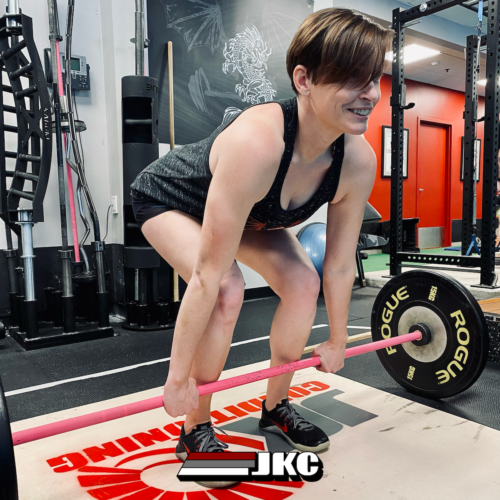
I had signed up for other gyms in the past and never went or rarely went. Something always got in the way or I was just too tired and lacked motivation to go. This way I’ve made a commitment to Jon or Thomas and I try very hard to keep my sessions once I’ve booked in. JKC is different from other gyms that I’ve tried in the past because no one is there to be “seen”. We are all there to get a good workout in and go on with our lives. And it’s a small gym so you get to know everyone and it’s like a big family. When I joined JKC, I couldn’t do a chin up with an elastic band, but I’ve slowly worked up to 10 free hanging chin ups. That was big because I hate chin ups.
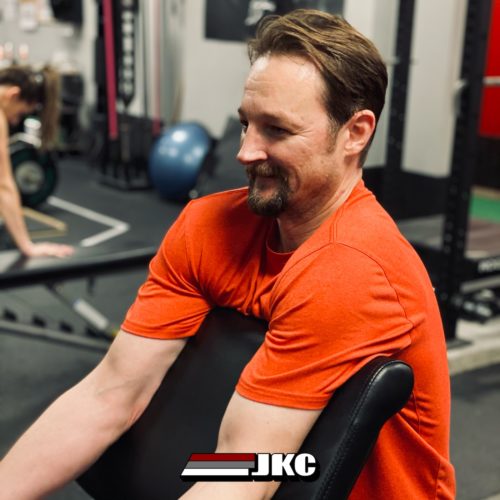
I had been struggling with work-life balance resulting in not exercising or playing hockey as much as I had been doing in the past. In addition to being out of shape, I was starting to experience some back/shoulder issues and realized I needed to make some changes. Around this time, a friend (who was also a client) recommended JKC and that’s when I started!
You really feel part of a community where everyone is welcoming and supportive. You get a program that is designed specifically to achieve your goals, with the ongoing coaching, progress tracking and support required to achieve them. The JKC team are very knowledgeable about fitness and conditioning, and very engaging with everyone to answer questions or discuss anything and everything training related. I also like the flexible scheduling and gym times that work for my schedule (I like early mornings and evenings).
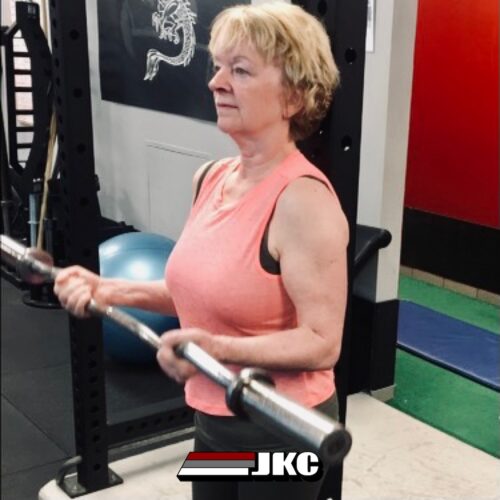
I am turning 67 next month and I started my journey with JKC in 2018. Seven years ago I experienced significant foot pain which had a negative impact on my day to day activities. I learned that issues in other parts of the body need to be addressed to achieve a positive result. My doctor (Dr. Jessica Wade) suggested, along with some other therapies, that I could benefit from the conditioning JKC had to offer. I previously had not trained in any gym. I observed how many gyms operated and had a sense that JKC would be more my style: training in a small group setting, having such personal attention, and a program meeting my specific needs is fantastic! I love the atmosphere at the gym. Everyone is accepted and you feel supported and comfortable.


































